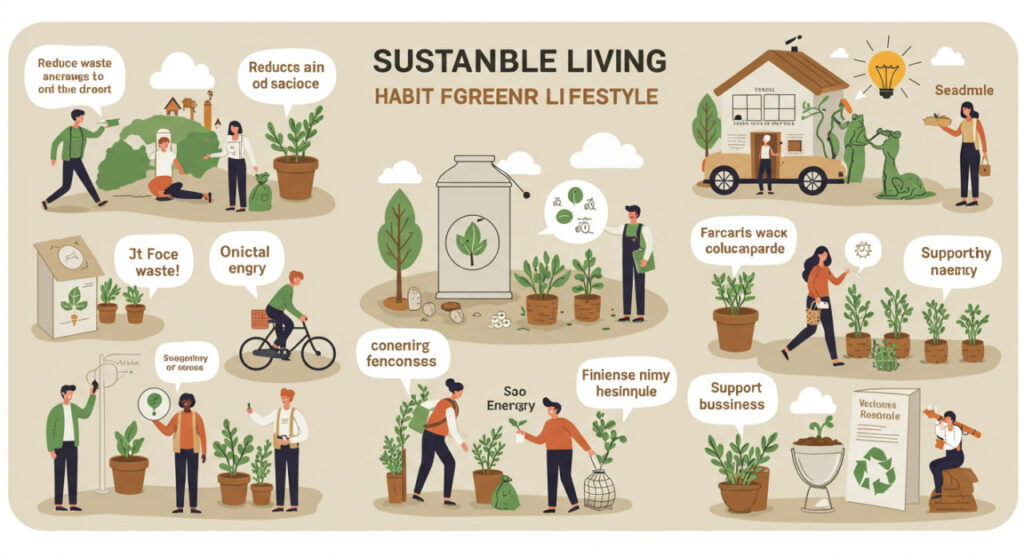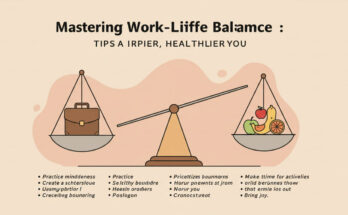In a world increasingly aware of environmental challenges, adopting a sustainable lifestyle is no longer just a trend—it’s a necessity. Sustainable living involves making conscious choices to reduce your environmental footprint, preserve natural resources, and promote a healthier planet for future generations. From small daily habits to significant lifestyle shifts, eco-friendly practices can transform the way you live while inspiring others to follow suit. This article explores practical, impactful habits you can incorporate into your life to embrace sustainability, with a focus on actionable steps, innovative tools, and the benefits of going green.
Why Sustainable Living Matters
The urgency of climate change, resource depletion, and pollution has brought sustainable living into the spotlight. According to the United Nations, global greenhouse gas emissions must drop by 45% by 2030 to limit warming to 1.5°C—a critical threshold to avoid catastrophic environmental consequences. Sustainable living empowers individuals to contribute to this goal by reducing waste, conserving energy, and supporting eco-conscious products. Beyond environmental benefits, adopting green habits can save money, improve personal health, and foster a sense of purpose by aligning your actions with your values.
The Impact of Small Changes
You don’t need to overhaul your life overnight to live sustainably. Small, consistent changes—like switching to reusable bags or reducing food waste—can have a ripple effect. For example, the Environmental Protection Agency (EPA) estimates that the average American generates about 4.9 pounds of waste daily, much of which could be reduced through mindful habits. By starting with manageable steps, you can build a foundation for a greener lifestyle without feeling overwhelmed.
Top Eco-Friendly Habits to Adopt
Embracing sustainable living involves integrating eco-friendly habits into your daily routine. Below are some of the most effective practices to help you live greener, complete with practical tips and tools to make the transition seamless.

Reduce, Reuse, Recycle: The Golden Rule
The mantra “reduce, reuse, recycle” remains a cornerstone of sustainable living. Reducing consumption means buying less and choosing high-quality, long-lasting products. For instance, investing in a durable stainless steel water bottle, like the Hydro Flask Standard Mouth (24 oz, $39.95), eliminates the need for single-use plastics. Reusing items, such as repurposing glass jars for storage, cuts down on waste. Recycling properly—by checking local guidelines and sorting materials—ensures resources are reused efficiently. Apps like RecycleNation can help you locate nearby recycling centers, making the process easier and more effective.
Embrace Energy-Saving Technologies
Energy consumption is a significant contributor to carbon emissions, but modern technology offers solutions. Smart thermostats, such as the Google Nest Learning Thermostat ($249), adjust your home’s temperature based on your habits, reducing energy use by up to 15%, according to the manufacturer. Switching to LED bulbs, which use 75% less energy than incandescent bulbs, is another simple upgrade. For those ready to invest, solar panels are increasingly affordable, with systems like the Tesla Solar Roof offering sleek designs and long-term savings. These technologies not only lower your utility bills but also reduce your environmental impact.
Smart Home Devices for Sustainability
Beyond thermostats, smart home devices like the Philips Hue Smart Bulbs ($129.99 for a starter kit) allow you to control lighting remotely, ensuring lights are off when not needed. Pairing these with a smart power strip, such as the TP-Link Kasa Smart Plug ($29.99), can eliminate “vampire energy” from devices left on standby. These tools integrate seamlessly into daily life, offering convenience while promoting energy efficiency.
Adopt a Plant-Based Diet
Food choices play a massive role in sustainability. Animal agriculture accounts for roughly 14.5% of global greenhouse gas emissions, according to the Food and Agriculture Organization. Shifting toward a plant-based diet—whether fully vegan or simply “Meatless Mondays”—can significantly lower your carbon footprint. Products like the Instant Pot Duo ($99.99) make plant-based cooking accessible, with features for preparing beans, grains, and soups effortlessly. Apps like HappyCow can guide you to vegan-friendly restaurants, while meal kits like Purple Carrot ($71.94/week for three meals) offer pre-portioned ingredients to reduce food waste.
Sustainable Transportation Choices
Transportation is another area where small changes yield big results. Walking, biking, or using public transit reduces emissions compared to driving a gas-powered car. For those who need a vehicle, electric cars like the Tesla Model 3 ($39,990 base price) offer zero-emission driving with increasing affordability. If an EV isn’t feasible, carpooling or using ride-sharing apps like BlaBlaCar can cut down on fuel use. For shorter trips, e-bikes like the Rad Power Bikes RadRunner ($1,499) provide an eco-friendly, fun alternative that’s perfect for urban environments.
Eco-Friendly Products to Support Your Journey
Investing in sustainable products can amplify your efforts. Below are some top-rated tools and brands designed to make green living easier and more effective.
Reusable Kitchen Essentials
Single-use plastics are a major environmental issue, but reusable kitchen products offer a solution. The Stasher Reusable Silicone Bags ($12.99–$21.99) are a versatile alternative to plastic bags, suitable for food storage and even sous-vide cooking. Similarly, Beeswax Wraps ($15.99 for a set of three) replace plastic wrap for covering bowls or wrapping produce. These products are durable, easy to clean, and reduce landfill waste while adding a touch of style to your kitchen.
Eco-Conscious Cleaning Products
Traditional cleaning products often contain harmful chemicals that pollute waterways. Brands like Seventh Generation offer plant-based, biodegradable cleaners, such as their All-Purpose Cleaner ($4.99), which is effective and safe for the environment. For a DIY approach, vinegar and baking soda can tackle most household cleaning tasks. Pair these with reusable microfiber cloths, like the E-Cloth General Purpose Cloth ($7.99), to minimize paper towel use.
Challenges and How to Overcome Them
Adopting sustainable habits isn’t without challenges. Cost can be a barrier, as eco-friendly products often have higher upfront prices. However, their durability and long-term savings often outweigh initial costs. For example, a $20 reusable coffee cup like the KeepCup Brew Cork ($32) pays for itself after a few months of avoiding disposable cups. Another challenge is convenience—fast-paced lifestyles make single-use items tempting. Planning ahead, such as meal prepping or carrying a reusable straw, can counteract this. Finally, misinformation about what’s truly sustainable can be confusing. Researching brands and prioritizing those with transparent practices, like Patagonia or Ecover, ensures your choices align with your goals.
The Benefits of Going Green
Living sustainably offers rewards beyond environmental impact. Financially, energy-efficient appliances and reduced consumption lower bills. Health-wise, plant-based diets and reduced exposure to toxic chemicals improve well-being. Emotionally, knowing you’re contributing to a healthier planet fosters a sense of accomplishment. Plus, sustainable living often inspires creativity—whether it’s upcycling furniture or experimenting with zero-waste recipes. By adopting these habits, you’re not just helping the planet; you’re enhancing your own life.
FAQ
What is sustainable living, and why is it important?
Sustainable living involves adopting practices that reduce your environmental impact, such as conserving resources and minimizing waste. It’s important because it helps combat climate change, preserves ecosystems, and ensures resources for future generations.
How can I start living sustainably on a budget?
Start with low-cost habits like reducing energy use, shopping secondhand, or cooking plant-based meals at home. Reusable items, like water bottles or cloth napkins, are affordable investments that save money over time.
Are eco-friendly products worth the cost?
Yes, many eco-friendly products are durable and reduce long-term expenses. For example, LED bulbs last longer than traditional bulbs, and reusable bags eliminate the need for single-use plastics, saving money and reducing waste.
How does a plant-based diet help the environment?
A plant-based diet reduces greenhouse gas emissions, water usage, and deforestation associated with animal agriculture. Even reducing meat consumption by one day a week can make a significant impact.
What are the best tools for sustainable living?
Smart thermostats, reusable kitchen products, and energy-efficient appliances are excellent tools. Brands like Hydro Flask, Stasher, and Seventh Generation offer reliable, eco-friendly options to support your journey.



